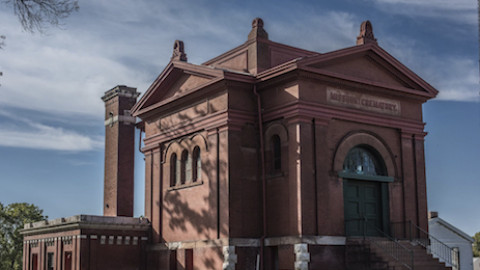
photo by Jason Gray
Just north of the Central West End, Fountain Park is one of the city’s most distinguished residential areas. Originally a subdivision known as Aubert Place, the neighborhood has fallen on hard times over recent years, but hope remains to see it restored to its previous grandeur.

photo by Dave Adams

photo by Shelly Cendroski

photo by Sharon Keeler

photo by Ann Aurbach
In 1857, rural land owner John Lay platted and then auctioned off more than 150 acres of his property for the establishment of a modern suburb to St. Louis called Aubert Place. His plan made provisions to care for his family, which is important because he died in the same year (my research was unable to verify if he made this plan in preparation for his death or if he died coincidentally). Nonetheless, Lay’s design for Aubert Place was much admired, though well ahead of its time, for its thoughtful emulation of neighborhoods in London and its centering around a small pocket park (St. Louis’ first public one, Lafayette Park, had only been in existence since 1851).

photo by Vivian Nieuwsma

photo by Ryan Stanley

photo by Irene Thomas
For nearly 20 years, the suburb remained mostly rural in character with several homesteads occupying the land surrounding the undeveloped oval park. In 1876, the founding of Forest Park and subsequent “Grand Divorce” of St. Louis City from St. Louis County, expanded the city’s boundary to include Aubert Place. Speculation of nearby neighborhoods, like the Central West End and Debaliviere Place, brought a building boom to the border of Aubert Place, as the city banked its resources on the economic potential of Forest Park. By the 1890’s, several streetcar lines made Aubert Place accessible to the rest of the city, and developers took a renewed interest. Much of the current neighborhood was constructed over the next two decades.

photo by Jason Gray

photo by Vivian Nieuwsma
Fortunate to the future built character of the neighborhood, only a handful of builders were responsible for most of the neighborhood’s buildings. Though less grand than the private places nearby, like Lewis Place, Fountain Park (rechristened after the city’s donation of a fountain centerpiece to the park -originally belonging to John Scudder, which he had himself donated to the Mercantile Library) possessed a characteristic refinement in its more modest dwellings, albeit with many of the architectural flourishes that established St. Louis’ building vocabulary of the time. Lay’s blueprint for Aubert Place likewise benefitted the neighborhood by laying out streets on a grid radiating outward from its central park, and in reserving lots on the four corners of the park for two churches, a university and a grand hotel. Though the hotel and the university were never realized, their planned inclusion did much to help “sell” the character of the neighborhood. Eventually, a commercial building was constructed on the northeast corner of the park, which remains to this day as one of the most elegant park-fronted commercial buildings in the entire city, despite its state of pronounced dilapidation.

photo by Ann Aurbach

photo by Jackie Johnson

photo by Jason Gray
During the early days of the neighborhood’s maturation, St. Louis’ Jewish immigration had not yet peaked, and most Jewish settlements still existed further east. Yet, in subsequent decades, that population continued to expand and move further west, and between the World Wars was roughly centered in the neighborhoods close to Fountain Park (the Jewish Hospital relocated to the edge of Forest Park in 1927). Like other minorities, Jews were excluded from living in certain neighborhoods due to St. Louis’ real estate practice of restrictive deed covenants, however, Fountain Park was an exception to neighborhoods nearby in that those documents were not issued extensively until almost the time when their nefarious implementation was all but eliminated. This meant that, by World War II, Fountain Park possessed disproportionately greater populations of both Jewish Americans and African Americans than most other neighborhoods, resulting in a pocket of racial diversity that was rare to find in St. Louis prior to the U.S. Supreme Court case of Shelley vs. Kraemer.

Tracy Jane Weidel

photo by Ryan Stanley

photo by Shelly Cendroski
In the 1970’s, Fountain Park began to fall on hard times, which exacerbated through the 80’s and 90’s, and continues to exist today. Many of the home owners during this time lived outside the neighborhood (even outside the city) and rented out their houses. The convergence from owner-occupied to renter-occupied brought about decline in maintaining those properties. This decline encouraged small businesses to leave. The diversity that previously existed began to fade, and the neighborhood became predominantly lower income. An attempt to revitalize the area in the late 1970’s, by building an urban mall, did not live up to its promise (much like a similar attempt in Old North St. Louis). Still, Fountain Park has somehow retained a proud character, and there is certainly plenty of opportunity for renewal here (a luxury apartment remodel is planned just across its southern border). Walking around the neighborhood, we had quite a few residents who engaged with us about our presence there, which is always a great sign. The area surrounding the park, the core of the former Aubert Place, is one of St. Louis’ most distinctive, and one would hope that there is still lots of future left in preserving this past.

photo by Jason Gray

photo by Tracy Jane Weidel

photo by Jackie Johnson

photo by Dave Adams
Map available here.







